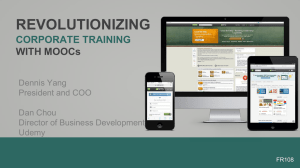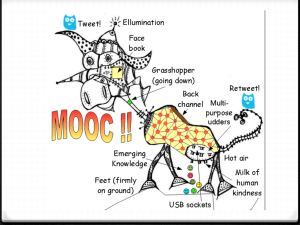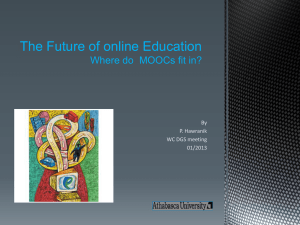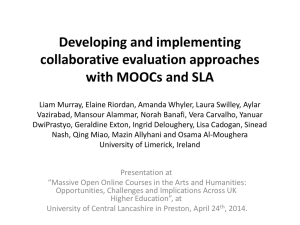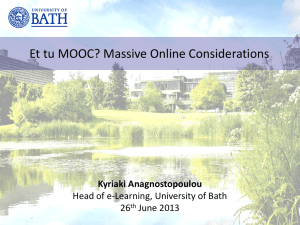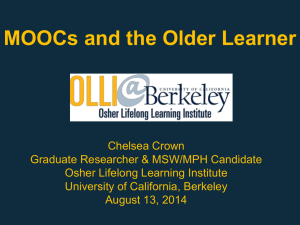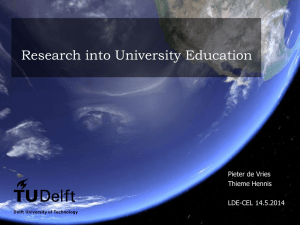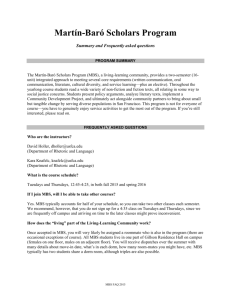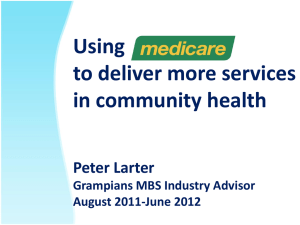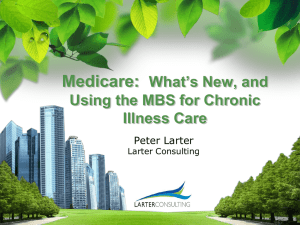Powerpoint - National Professional Science Master`s Association
advertisement
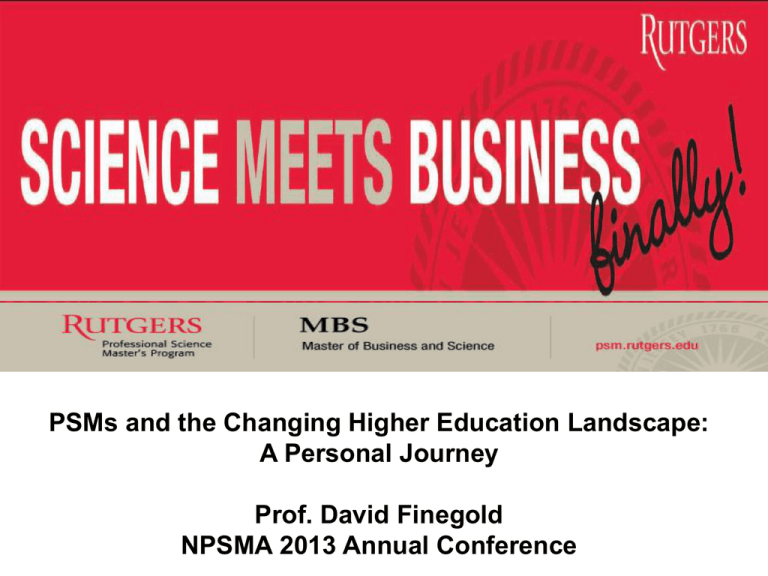
PSMs and the Changing Higher Education Landscape: A Personal Journey Prof. David Finegold - Do Not Forward NPSMA Confidential 2013 Annual Conference Chapter 1: Birth of the PSM The Keck Graduate Institute of Applied Life Sciences Confidential - Do Not Forward Creating a Stand Alone PSM College Vision of Founding President: Hank Riggs 10-year tenure as President of Harvey Mudd College Maintain Claremont College’s unique growth model Raised $50 M Founding Gift Later added a $20 M challenge grant A two-year program designed specifically to develop leaders for the Life Sciences industry Decoding of the Human Genome Realization that ½ of bioscience grads entered industry, but had no explicit preparation for it Build integrators between MBAs & PhDs Confidential - Do Not Forward Key Features of the Master’s of Bioscience (MBS) • • • Took advantage of the opportunity to start with a blank sheet of paper • Deep integration between sciences & business • No departments • Not confined by existing academic schedule • Long-term contracts > tenure -- controversial Extensive ties with the bioscience industry from the outset • Source of many founding faculty • Paid internships for all students • Built a great board & advisory board Inquiry-driven, team-based learning: Captone Team Master’s projects • Adapted model from Harvey Mudd nd revenue Confidential - Do Forward • $50,000/project becomes 2Not stream 28 Students in Our First Class of Graduates Confidential - Do Not Forward Lessons Learned and Challenges • • • • • Evolved in parallel and partnership with growth of PSMs led by the Sloan Foundation • Uneasy initial relationship – not sure if same creature • Decide better to be part of a movement Benefits & drawbacks to being a standalone college • New institution plus new degree • Only possible because of Claremont Colleges unique model Shift to greater emphasis on business & regulatory • Reflects student interest & career paths • But not reflected in initial choice of degree name Struggle to find right profile, activity mix for faculty • Balancing demands for research, teaching & service Location less than ideal for industry interaction, part-timers Confidential - Do Notcampus Forward • Contemplated move, branch in San Diego cluster Part II: Creating A Statewide PSM System • Translate lessons from KGI into a public flagship research university – First graduate degree to span all 3 Rutgers campuses, 15+ Schools – MBS = Master’s of Business & Science • Raise over $2 million in start-up grants – NSF, DoL, DoEd, Sloan, NJ, Internal seed money – Tied to wider efforts to build NJ bioscience cluster: WIRED Bio-1 • Create a governance & financial model to foster cooperation & innovation – – – – Modular design to allow for new degree tracks Money flows to teaching department Grad schools grant degrees, Continuing Ed supports Strong central leadership: Prof. Deborah Silver Enrollment Growth in Rutgers’ PSM MBS Quick Facts: • April 2010: MBS Degree was formally approved • September 2010: First official class • May 2012: First MBS graduating class – 24 students. May 2013 – 49 students • 2013: 29 concentrations. 3 campuses: New Brunswick, Newark, Camden Lessons Learned & Challenges • Modular structure key to speed & adaptation – But limits deep integration within tracks • Difficult to gain buy-in from many schools – My faculty see as distraction, rather than way to elevate profile & serve broader group of students – B-school resists as lower cost competitor they don’t control • Vital to have local champions • Crucial to have a few courses owned by the program – Self-sustaining tuition flow • Easy to sign international partnerships, hard to drive student flow Part III: Disruptions in Higher Education • Incremental changes that began with PSM movement are now accelerating – Current HE business model unsustainable for many institutions • Exciting experiments with new models The US has lost Higher Ed Advantage And Low Growth in Completion Rates Percent of Age Groups with a Degree The Squeeze on the Middle Class Decline in State HE Funding Higher Education Expansion in China Enrollment in higher education as % of 18-22 age population: 1990-2010 30.0% 25.0% 20.0% 15.0% 10.0% 5.0% 0.0% 1990 1991 1992 1993 1994 1995 1996 1997 1998 1999 2000 2001 2002 2003 2004 2005 2006 2007 2008 2009 2010 Source: China Statistical Abstract 2011 • Latest 12-month average: March 2012–February 2013 Note: Underemployment data are only available beginning in 1994. Data are for college graduates age 21–24 who do not have an advanced degree and are not enrolled in further schooling. Shaded areas denote recessions. Source: EPI (2013), analysis of basic monthly Current Population Survey microdata The Impact of Technological Change • Advances in artificial intelligence (AI) could displace many workers • Elliott (2008) analyzed 52 capabilities required for existing occupations compared with advances in AI research – Language – Reasoning – Vision – Movement • By 2030 predicts computers might be superior to humans in 60% of current jobs – Treat with major caution • Not predicting mass unemployment, but major implications for education, occupational structure, distribution of wealth – Danger of reinforcing barbell economy New HE Models Competency-Based Models Learn just what you need, when you want: New Charter University • New start-up in 2011 • For-profit adaptation of Western Governors U model • Can start for free – pay only if you want credits • $199/month for as many courses as you want • Each class begins by testing for prior learning – only cover what’s needed : Degrees May No Longer Be Required • Founded in 1999 • First Indian Business School to crack the FT’s Global Top 100 rankings – Top 20 last 3 years • Doesn’t offer a degree – Post-grad 1-year certificate = billed as equivalent to MBA • How did they do it? – Leveraged brand names of leading global B-schools: Kellogg, Wharton, later LBS – Boards filled with top employers D e g r e e s N o New Models: India School of Business New Models: American Honors American Honors is a 2-year honors program designed in partnership with community colleges to broaden access to top 4-year degrees • New, competitive 2-year Honors program at community college • Small classes, top faculty, personal advising, cohorted peer group Transfer • Partner with top 100 public and private colleges and universities • Address the “undermatching problem” • Lower costs of first two years of undergraduate education by 4090% 2 Earn Associates degree with Honors after first two years + 2/3 Earn Bachelors degree from Top 100 University after two more years 22 School of Management and Labor Relations Massive Open Online Courses • MOOCs = the dominant new HE phenomenon of the last 2 years – Classes with 150,000+ students at a time – Huge potential global benefits in educational access – Dramatic change in the online conversation for most elite universities • From resistance to Presidents being fired for not moving fast enough • Explosive growth – Coursera 4+ million students with 500 courses from 50+ top global universities by Fall 2013 School of Management and Labor Relations MOOCs = the Trifecta Affordability, Flexibility, Brand AFFORDABILITY New Charter U MOOCs: Coursera, Udacity, EdX High Low High USC Online, Rutgers, ASU BYU-Idaho, UNT-Dallas Low Low High EDUCATIONAL QUALITY/BRAND VALUE CONVENIENCE/ FLEXIBILITY School of Management and Labor Relations Some Lesser Known MOOC Facts • Sebastian Thrun attracted over 150,000 to his first AI MOOC by sending 50 e-mails • Top 400 performers in his Stanford course were taking MOOC version • Most of those completing early MOOCs have degrees 25 School of Management and Labor Relations Early MOOC Issues • Potential reputational risk if not done well – Example of failed Georgia Tech course, ironically on “How to teach online” • High attrition rates in version 1.0 – though many never intended to complete • Have costs, but no clear business model • Concerns re: assessment, learning method – Although improving rapidly • May create expectation in new generation that educational content should be free – ala news, music School of Management and Labor Relations MOOCs 2.0: Georgia Tech’s Master’s in Computer Science • Enable full degree from Top 10 Program for $6,600 vs. $30-45,000 tuition + living for face-to-face • Partnership with Udacity andAT&T $2 M gift • Serve AT&T employees and military in initial ‘pilot’: 600 vs. 300 in current face to face program • Goal is 2000 students within 3 years generating $5 Msurplus/year • Potential major threat to many existing PSMs if successful School of Management and Labor Relations Georgia Tech MOOC Master’s Concentrations at the outset • Computational Perception & Robotics • Databases & Software Engineering • High-Performance Computing • Interactive Intelligence • Machine Learning • Networking • Social Computing • Systems Forces That May Sustain Existing HE & PSM Models • Colleges & universities = long-lived institutions – Only organized religion = older • Produce many benefits beyond graduates – Key stakeholder, employer in local communities • Demand for selective colleges at all-time high • ROI on degrees remains relatively high – No guarantee of a job, but better than the alternative in knowledge-driven economy • Surge in international students Growth in International Students to US International Students 800,000 700,000 600,000 500,000 400,000 300,000 200,000 100,000 0 1990/91 1995/96 2000/01 2005/06 Data from the National Center for Education Statistics. 30 The data collection process was changed in 1974/75. Refugees were counted from 1975/76 to 1990/91. 2010/11 What Can We Expect in 5-10 Years? • Nobody knows – Rate of change, plus number of disruptive & contradictory trends makes any predictions suspect – But here we go anyway… • Likely to mirror growth in inequality in wider society – Rich get richer: global brands & students, endowment, alumni networks, leverage top profs with MOOCs – Majority of institutions and faculty struggle • Ongoing challenges with graduate employment – Growth in supply outstrips new high-end jobs • Disruption likely greatest… – On margins of existing systems – Where graduates can demonstrate competence objectively – End of high school, first two years of college • Misaligned spending & value Bricks & Mortar Can Be a Liability Will universities go the way of bookstores, video stores and newspapers? What Can We Expect in 5-10 Years? • Not likely to see leading publics and privates fail – On campus experience still offers superior value to online education for 18-24s (and their parents) – Added element of selectivity, screening, networking • But likely to see unprecedented reduction in # of HE institutions – Discount rate already 60+% – Failures and mergers – Could be up to 1/3 of privates outside the top 200 – Uncertainty re: public support – mandated growth in entitlements suggests continued squeeze PSMs Must Continue To Innovate • Focus on elements hardest for fully online to emulate – Lab-based applied research – Integrating force for interdisciplinary collaboration, entrepreneurship & job creation – Building effective global teams & partners – Creating strong sense of community – Opportunities to meet, network with industry leaders – Adapt to the market – Treat MOOCs as feeders, rather than competitors • Impressed by KGI range of new offerings – Postdoctoral Professional Master’s – business for PhDs – Post-baccalaureate Premedical Certificate – PharmD – new school seeking accreditation – Bold experiment with the Minerva project Goal of Professional Science Degrees: To create T-shaped Technical Professionals Overall, we find some degree of mismatch between the skills current engineers have and the skills that employers say they are seeking. In interviews with engineers and managers in a wide range of firms, we find consistent reports of skill deficits. These skill deficits are broadly identified as communications skills and the related ability to work across a variety of “borders” — organizational, technological, disciplinary, as well as cultural and national. -Engineering and Engineering Today's competitive industrial marketplace calls for “T-shaped technical professional, who have skills both broad and deep. In addition to being deep problem solvers with expert problem-solving skills in their home discipline, T-shaped scientists (and engineers) are also entrepreneurial and good at communicating with non-specialists - Taken for Granted, Fitting the Job Market to a T, B. Benderly, Science Career Magazine, September 05, 2008. Skills - What's really needed for global competivenss", Salzman and Lynn, 2010. Ability to apply knowledge and skills across a broad range of areas Disciplinary Skills “We’re looking for technical folks who can talk to people, not just computers.” ~MBS IAB Member MBS Curriculum Pyramid Capstone project – two semester company sponsored team consulting project TMP Elective Courses Gain work experience in a career area of interest Advanced technical or business courses oriented towards specific careers in Industry => students can “major” in an area of interest Paid Industry Internship Core Technical and Business Curriculum Copyright © 2007 Jane Creech Undergraduate Science Degree Graduate science and MBS-level business courses focused on bioscience industries Some Sample TMP Corporate Sponsors www.kgi.edu Master of Business & Science (MBS) • Combination of a traditional MS and core of an MBA -- integrated framework. • Concentrated tracks in science & engineering: – • • • • “MBS with a concentration in ****” profession based not academic 8 courses in science discipline, 6 in business+ Capstone course project Internship/research component Part-time or Full-time option
